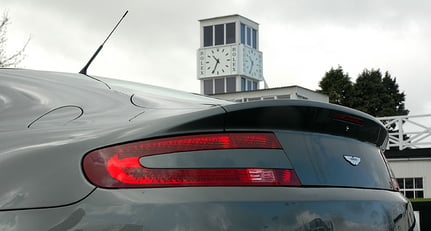
Forget the hype, the waiting lists, the acres of breathless motoring prose - a hundred miles or so on twisting British roads will convince you that this may well be the best car in the Aston Martin range and, ‘bangs for your buck’, the finest sporting car in the world.
Eagerly-awaited, or what? When Astons announced the introduction of a ‘junior’ car to the line-up, a theoretical pricing point in 911 territory (not subsequently held to, and more a figment of the collective motoring press’s imagination than fact emanating from Gaydon), and the gorgeous styling of the prototype (made even more desirable in execution) led to an unprecedented demand for the car. Could it ever measure up against such unheard of anticipation?
Having had the keys of a well run-in demonstrator for a few days I can report that familiarity breeds a desperate desire for long-term ownership that would normally only have been assuaged by cars in the £120 - 180k bracket. It’s that good.
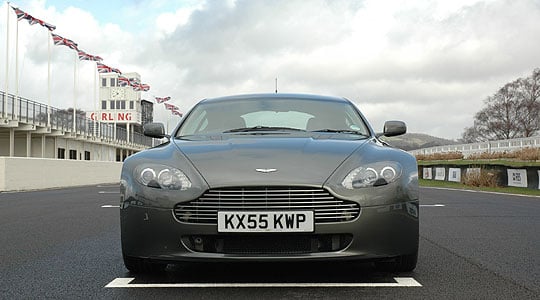
Featuring, as it does, a fair percentage of DB9 componentry and styling, the V8 Vantage cabin seems a familiar place. Unfortunately the company did not use the opportunity to make the dash (carried over, I would say, pretty well intact from the ‘9), nor the sat-nav, an option fitted to the test car, more legible. A 220 mph (the car tops out at around 175 mark) speedo means that 100 mph - licence-losing territory here in the UK - is less than half way round the dial. Luckily the digital readout can come into play, although that’s difficult to read in bright sunlight too. Ho-hum, it’s not a BMW or Mercedes I suppose. Seating again appears identical to its older brother, easily adjusted to two different 6’ 4" passengers I carried, although again lacking in lower lumbar support.
Negatives aside, it’s now uphill all the way. The all-alloy, dry-sumped, 4.3 litre V8, built by Aston Martin technicians in Germany, belies its high-revving nature (380 bhp @ 7,300 rpm, 417 Nm/307 Ib.ft torque @ 5,000 rpm) by being very tractable and smooth throughout the rev range. It is not in the league of the Ferrari 430, with an extra 110 bhp, and those who criticise it for its lack of irresistible urge, like that exhibited in the CLS AMG 55 we tested recently, should be reminded of what such passions sometimes lead to - trouble.
You can floor the accelerator in any gear and sure the scenery starts passing by pretty quickly, but you feel totally in control and the way the taut suspension hung on an ultra-stiff chassis holds the road, the steering transmitting every nuance of twist and turn and the engine responding to microscopic measures of throttle, is sublime. There’s never the big moment when a lot more power suddenly kicks in and you have to back off. A two-wheeled comparison would be a 600 versus 1000 cc superbike. They will, unless there’s a monstrous straight involved, cover the same distance in pretty well the same time, the smaller machine just needing a little more rider input. I can fully understand why the V8 Vantage has lapped the ‘Ring in very competitive times, it’s so easy and rewarding to drive.
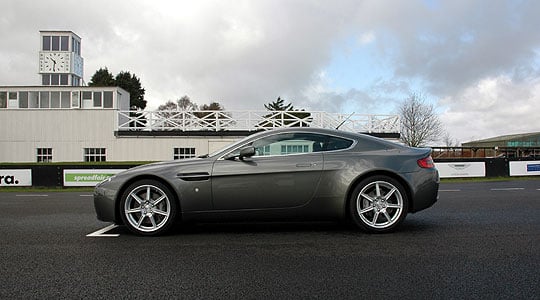
But if you’re only looking for neck-snapping acceleration you may be disappointed, it’s too sophisticated a package for that.
Let’s take a breather to describe the architecture of the car. Using the company’s VH platform technology, Aston Martin are able to quickly react to model changes yet still have a tried and tested chassis that meets all the latest legislature, and combines with other ‘family’ components like the interior, double-wishbone suspension and transaxle gearbox. It’s an immensely stiff chassis structure that’s able to take the harder set-up of the new car in its stride. The natural compactness of a V8 means the motor can be mounted well back, the dry-sump lowers the installation, and together with the transaxle and short overhangs, the car has all its weight low down and well within the wheelbase, thus allowing go-kart-like handling and very quick changes of direction.
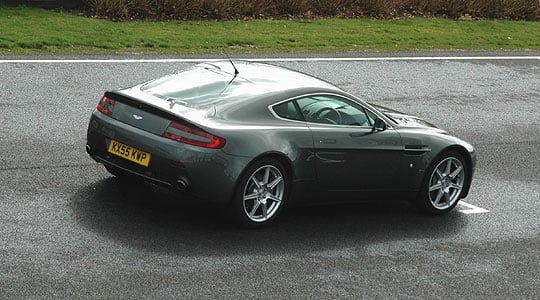
What, no sequential gearchange? No, you’ll have to do it the old-fashioned way (for the time being) as the six-speed Graziano ‘box is activated by stick rather than paddle. It’s a nice change (when warmed-up), and the clutch is not too heavy, allowing a fair degree of motorway-queue misery on the way back from Goodwood last Sunday. And Astons have used the very effective torque-tube set-up with a carbon prop shaft from the DB9 connecting engine to gearbox, thus adding to the overall stiffness and solidity. The brakes do the job - although the pedal felt a touch ‘dead’. Perhaps a result of the rest of the car showing such finesse.
Externally the car is a stylistic tour de force. Small and compact, yet not stubby or squat, the V8’s composite and aluminium bodywork appears more ‘mini-Vanquish’ than ‘junior-DB9’. It is a fantastic looking car that retains all the core values of the marque (masculinity, power, presence) in an overall footprint similar to the latest 911. Porsches have grown, Aston Martins have shrunk and yet it’s the British company’s product that that has carried the transformation off the better.
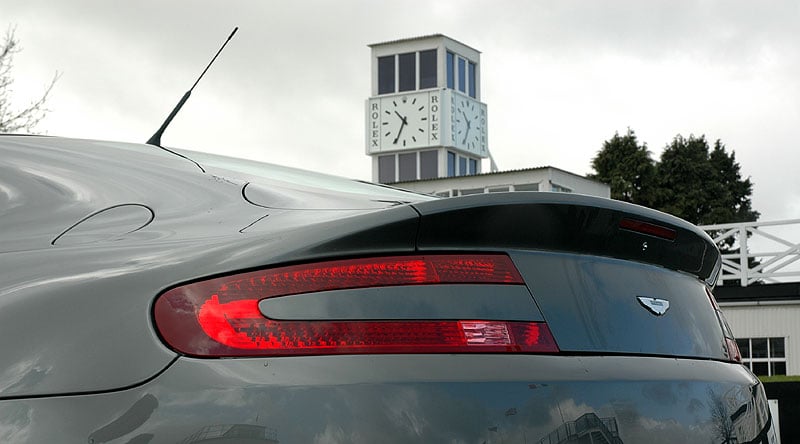
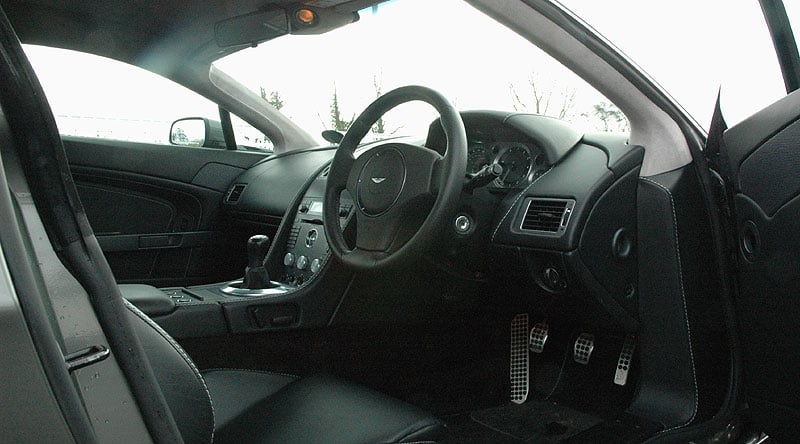
Inside there are only two seats with a parcel shelf, and the boot is accessed via a hatchback for the first time since the innovative DB2/4 of the 1950s. Don’t expect to be able to pack a lot of gear, but than again the DB9 and Vanquish are not exactly capacious.
Anything left to say? Not really, take it from me, it really is as good as people say it is, and for those of you agonising over the cost/performance/911 conundrum, what would you rather say you were driving, eh? And I haven't mentioned the exhaust-note once.
The Aston Martin V8 Vantage has an on-the-road price in the UK of £79,995. The test car was finished in Mercury Silver with full leather, 'Monotone', in Obsidian Black with Grey stitching (£695), as well as options that included:
7 spoke lightweight aluminium alloy wheels. Front: 8.5J x 19". Rear: 9.5J x 19" with Tyres - Front: 235/40 ZR19. Rear: 275/35 ZR19 (£995). Satellite navigation system (£1,750), Aston Martin Audio - Premium System (£995), Integrated telephone system (GSM) (£795), Heated front screen (£295).
The total price of the car as tested was £87,890.
Text: Steve Wakefield
Photos: Classic Driver - with grateful thanks to Goodwood
ClassicInside - The Classic Driver Newsletter
Free Subscription!
